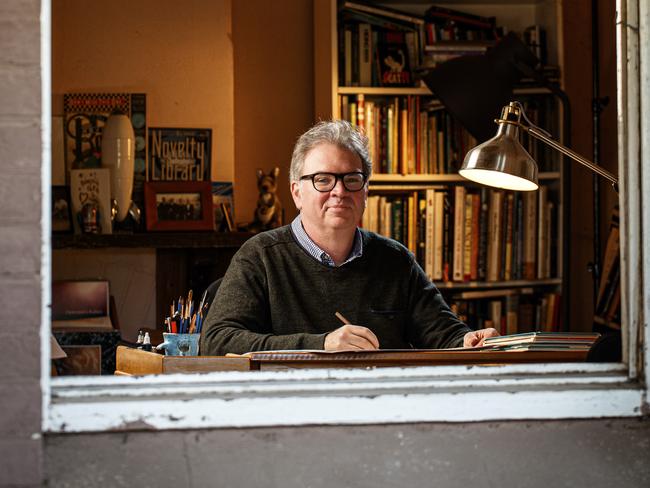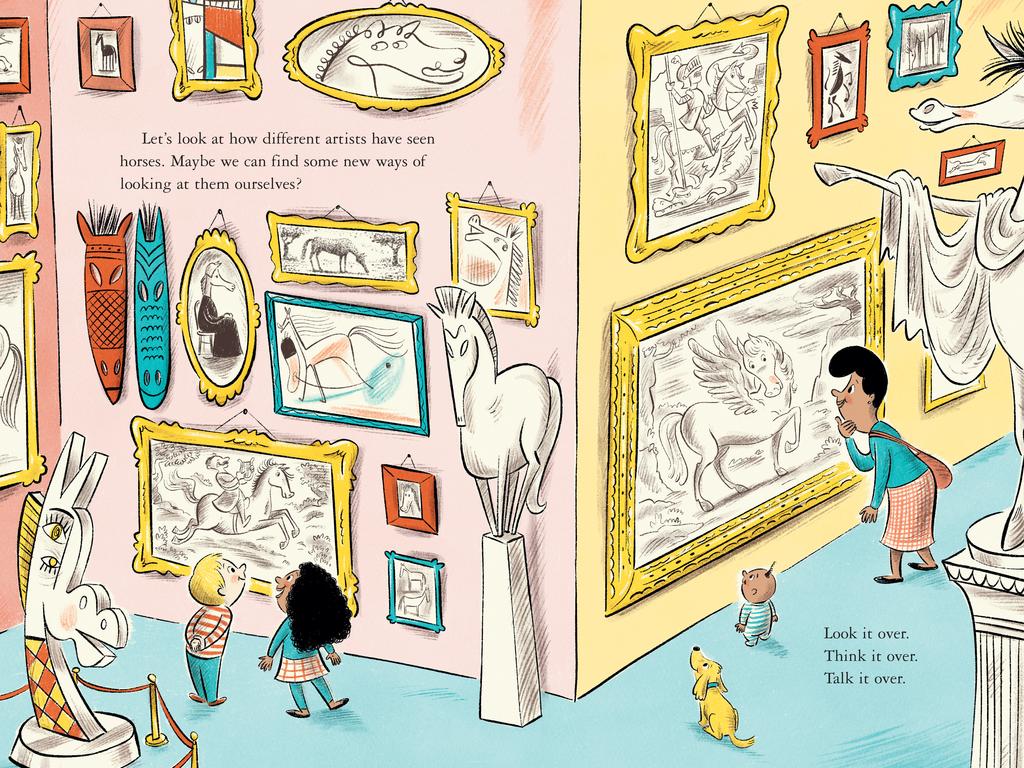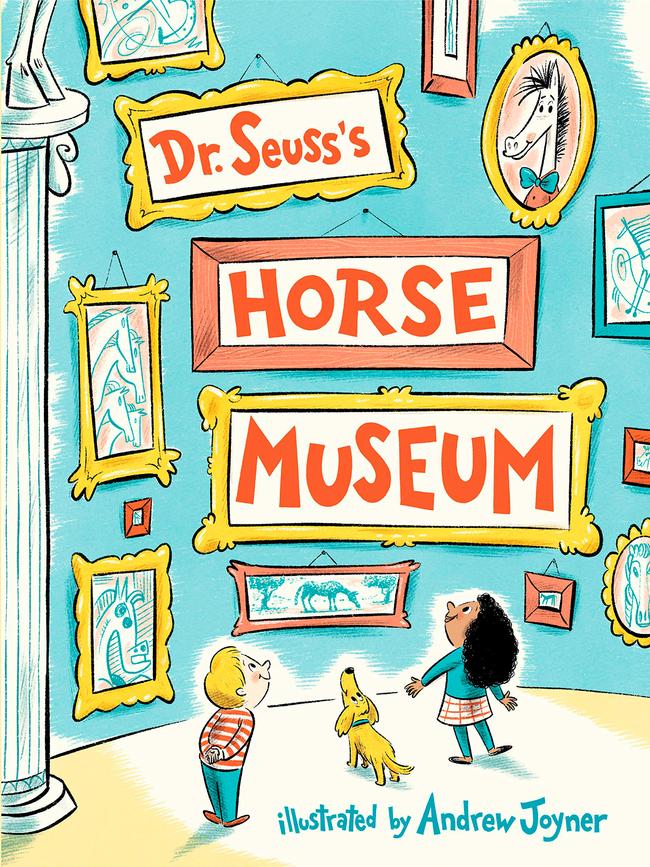Final masterpiece of Dr Seuss brought to life in SA
It’s the type of story you only read in fairytales — a secret offer to a SA artist to bring Dr Seuss’s lost manuscript to life. And now, finally, Andrew Joyner can reveal his biggest secret.
It was the kind of thing you might read about in a children’s storybook.
In a cottage on the outskirts of a pretty town in the countryside, a man receives a mysterious message from far, far away.
He doesn’t know it yet, but that message marks the start of a journey that will take him far from home, and open the door to a new world of opportunity.
Andrew Joyner is an illustrator, with a string of successful children’s books to his name. You may well have read some of them to your children or grandchildren: The Terrible Plop, Too Many Elephants In This House, Duck and Hippo and the Boris series, among many others.
He works from his home in Strathalbyn in the Adelaide Hills, where he lives with his wife and two teenage children.
READ MORE ABOUT DR SEUSS
■ PROPERTY INVESTMENT ADVICE FROM DR SEUSS
■ THE BEGINNER’S GUIDE TO THE LORAX
It was there, sitting at his desk one day, that he opened an email from his agent in the United States.
Random House publishers had been in touch and wanted him to sign a nondisclosure agreement on a mystery project.
“Why not?” thought Joyner.
The project turned out to be the publication of an unfinished manuscript, long-buried and only recently discovered, by none other than Dr Seuss.
Random House wanted Joyner to illustrate the book. Called Dr Seuss’s Horse Museum, it will be published here and in the US next week.
“I was pretty amazed,” says Joyner. “It’s hard to imagine. I still don’t know exactly why they thought, ‘Oh yes, he’s the person to do this’. I didn’t want ask,” he adds, laughing. “I thought I’d wait till I finished. But I still find it kind of remarkable that they went … Here! Because there are lots of people who could do it, I’m sure.”

Joyner is tall man with a friendly, open face and a ready smile. It’s immediately clear why he’s a popular guest at schools, which he visits frequently, reading to kids from his books and showing them how he creates them.
Like millions of others the world over, he had read and loved Dr Seuss books as a child (he’s about to turn 50). “I’ve probably been influenced by that, by his style … how I draw, without me knowing it,” he adds.
Dr Seuss’s Horse Museum is the only nonfiction book by Theodor Seuss Geisel, the American illustrator whose book The Cat in the Hat turned reading instruction for children on its head and became an instant sensation after its publication in 1957.
In a new biography, Becoming Dr Seuss: Theodor Geisel and the Making of an American Imagination, Brian Jay Jones recounts how Geisel had been commissioned by the head of publishers Houghton Mifflin’s education division to come up with “a story that first-graders can’t put down”.
Not only did they want a page-turner, the publishers required the text to be drawn from a pre-approved list of 350 simple words, with the whole running to no more than 250 words.
Apparently Geisel almost gave up on the task, telling one person that if he came up with two words that rhymed and made sense, that would be the title. “Cat” and “hat” provided the breakthrough he needed.
Geisel’s sense of fun, his gift for inventive language and witty rhymes, and his slightly subversive characters, were a revelation in the dreary Dick and Jane world of reading primers.
Dr Seuss became a household name, and books like Hop On Pop, One Fish Two Fish Red Fish Blue Fish, Green Eggs And Ham, The Lorax, How The Grinch Stole Christmas, and Horton Hears a Who have enchanted children as well as adults ever since.
Geisel died in 1991, but his books and his characters live on, under the careful stewardship of Dr Seuss Enterprises in California.
After his death, Geisel’s widow, Audrey, found the manuscript for Dr Seuss’s Horse Museum when she was cleaning out his study.
According to his US publisher and art director, Cathy Goldsmith, the manuscript went into a box in a cupboard, and was forgotten.
“In 2013, the box was rediscovered by Audrey and Ted’s long-time assistant, Claudia Prescott,” says Goldsmith.
“Coincidentally, What Pet Should I Get? (published in 2015) was found in the same box.” Both manuscripts are thought to date from the early ’50s.
Written as a guided tour of an art gallery, Dr Seuss’s Horse Museum shows readers how different artists have depicted horses in real artworks, reproduced and embedded in Joyner’s illustrations.
Geisel’s unfinished manuscript contained just simple sketches and minimal text, with notes pointing to later inclusions about the various artworks.
“They reckon that it was just before One Fish Two Fish Red Fish Blue Fish, because the characters are the same,” says Joyner.
“He did a TV show about this, but it’s been erased. He wasn’t actually on it, but he wrote the script. But it was about modern art, and that was in the early ’50s.”
Joyner had first come to the attention of Dr Seuss’s US publishers when he was commissioned to update the illustrations on an out-of-print title called The Hair Book.
At the same time, they were publishing his book The Pink Hat, written and illustrated by Joyner to celebrate the 2017 Women’s March.
Having received his commission, he did his best to ignore any sense of the burden of expectation at the prospect of a previously unpublished Dr Seuss book.
“I tried not to dwell on how significant it was, or the fact that it was Dr Seuss. I just tried to focus on getting the work done,” he says.
Working with Goldsmith, and editor Alice Jonaitis, Joyner was set free to put his own stamp on the book. “I had a conversation with Cathy and Alice early on and they were really good. They said, ‘We don’t want you to imitate his style, just do it. We got you because of you, we just want you to do it in your own style’, so I felt like I had quite a bit of freedom,” says Joyner. “The roughs (Seuss’s manuscript) were actually very rough.”
He came up with the idea of creating a horse character that would act as a guide through the museum.
“I wasn’t sure they’d go for it, but they did like it. So then I just sort of solved the problem. It’s a bit like problem solving, illustrating, a lot of the time. And if I focused too much on ‘it’s a Dr Seuss book’ that wouldn’t help me solve the problem.”
Goldsmith said that when asked to provide a sample illustration for the Horse Museum book, Joyner had submitted multiple sketches.
“All showed that Andrew is what I call a thinking illustrator,” she says. “He is as intelligent as he is talented. And Andrew had a clear vision of how to combine illustrated art with photographic reproductions of museum artworks.”
Goldsmith worked with Geisel on six books, from 1978 until his death.

“Ted was very smart and a great teacher,” she says.
“He was often reserved with new people, but had a devastating sense of humour once you got to know him. I feel very lucky to have gotten to know Ted. I feel even luckier to have worked with him. Even today, I hear myself saying something to an illustrator and think, ‘I learned that from Ted’.”
According to Jones’s biography, Geisel fell in love with Australia during a visit in 1964, and jumped at the chance to return when his UK publisher, who also sold the Seuss books into the Australian market, proposed a tour of Australia and New Zealand in 1976.
“The Geisels were whisked across the region in high style, galloping through Sydney, Melbourne, Brisbane and Adelaide, and feted wherever they went,” writes Jones.
“Ted talked at length about literacy,” Jones continues, “sounding genuinely alarmed about reading competency in the United States — especially compared with Australia, which he called ‘the most literate country I have ever visited … Everyone (here) reads anything they can get their hands on’.”
On the title page of Dr Seuss’s Horse Museum, we catch the first glimpse of Joyner’s horse character as a sketch being drawn by a man sitting in the foyer of the museum.
“He’s kind of like a reference,” says Joyner of his horse.
“You see at the start my character of Dr Seuss drawing the horse. That’s a sort of ’50s Dr Seuss, before he got the beard and glasses and stuff. And he’s there at the end with all his books. So it finishes with a nice little tribute to him and his books.”
Apart from learning about how artists work, seeing from real artworks the different ways they perceive and represent horses in the pieces they create, readers can also have fun spotting familiar Seuss characters.
A glimpse of a top hat, a gloved hand holding an umbrella and a furry foot is instantly recognisable as the cat in the hat, about to round the corner.
Horton the elephant is helpfully lending his trunk to carry a painting of horses pulling a heavy load. The cat makes several other appearances, along with various other Seussian-looking characters.
One of the hardest things about the assignment was keeping it secret.

Having signed the nondisclosure agreement, Joyner had to keep it under wraps for 18 months, until the publisher unveiled the cover image last February.
“I didn’t keep it secret. It’s hard to keep a nondisclosure agreement from your wife,” says Joyner.
He didn’t tell his kids, however, and stonewalled his brother-in-law, journalist and broadcaster David Penberthy.
“He knew there was something up,” says Joyner.
“He came up with some crazy guesses. He thought it was a George Clooney or Michelle Obama picture book or something. But he didn’t guess it.”
Joyner grew up on the River Murray at Mannum, and met Penberthy at Adelaide University, where they both worked on the student newspaper On Dit.
Penberthy did words while Joyner drew cartoons and layouts. His friend introduced him to his sister, Rebecca, and the couple have been married for 22 years.
Joyner was studying for a PhD in English Literature, coincidentally the same degree Geisel completed at Oxford, and working part-time at Big Star record store.
Disillusioned with the prospect of a career in academe, he quit the PhD program and went to work full-time at Big Star.
With his wife’s encouragement, he began submitting illustrations to newspapers and magazines. His first published image was in the now-defunct Bulletin magazine. Commissions from The Sydney Morning Herald and The Age followed, and before long, Joyner had enough work to taper off his hours at the record store.
It was his work in a less mainstream outlet, the NSW Department of Education’s School Magazine, that brought him to the attention of Penguin children’s publisher Jane Godwin.
“She sent me the manuscript for The Terrible Plop and said, ‘Would you like to have a go at doing a children’s book?’,” he recalls. The text had been written by acclaimed children’s author Ursula Dubosarsky.
“I didn’t realise I wanted to be a children’s book illustrator,” says Joyner. “I was just lucky that someone else did know that I wanted to do it.”

Being paired with a writer of Dubosarsky’s calibre was a dream start. The book was a success, and rights were sold into the US market.
“I was probably a bit naive,” he says, “because then I thought, ‘Oh, every book must just get picked up by American publishers’. That doesn’t always happen. So I was really lucky to have that as my first book. I loved doing it.”
His children loved it too, and the couple has a treasured video of their daughter, then aged 3, sitting on her bed, reading aloud from The Terrible Plop.
“It’s very catchy,” he says. “It was the perfect first book to do. I can’t believe my luck sometimes. Because you don’t really plan for these things. And it’s almost like if you pursued it, it probably wouldn’t happen.”
Although the creative process of illustrating Dr Seuss’s Horse Museum was, once he’d settled into it, just like any other, the attention it has generated is not. Just the unveiling of the cover in February caused a flurry of interest in the US media. This weekend, the entire Joyner family is en route to the US for the launch and more media interviews, including on national TV show Good Morning America.
Joyner is obviously quietly pleased, but slightly bemused, by the prospect, and vague about what impact the book is likely to have on his career.
Was his US agent excited?
“I don’t know,” he replies. “I haven’t asked her. I don’t want to jinx it. But it obviously gives you a bit of attention. It’s a pretty high profile job. And I do find that funny, that they chose me. I mean, you’re sitting in Strathalbyn and this comes through on your email. I do find that strange.”
Whatever the outcome, one senses that not too much will change in the Joyner household. He is clearly a happy man, one who, almost by accident, has found his metier.
“There’s something about — it sounds a bit naff — but there is something about story-telling that is captivating to work on,” he says.
“And I just like drawing the character, and just building the world that they’re in.”
Dr Seuss’s Horse Museum, published by Puffin, $27.99, is on sale Tuesday.

